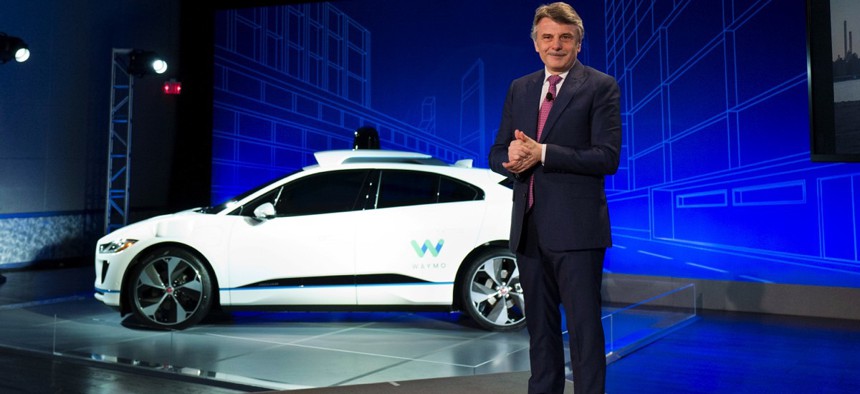City Leaders Envision Future With Driverless Cars

Self-driving car pioneer Waymo will buy up to 20,000 of the electric vehicles from Jaguar Land Rover to help realize its vision for a robotic ride-hailing service. Mark Lennihan / AP Photo
Autonomous vehicles promise increased equity and efficiency, but a new report says governments need to make sure the right policies are regulating them.
Large cities are rapidly including self-driving vehicles in their long-range transportation plans, with 24 U.S. municipalities committed to piloting the technology, a new National League of Cities report found.
The Global Atlas of Autonomous Vehicles in Cities also shows 18 U.S. municipalities studying policy issues raised by AVs.
In 2016, only 6 percent of major U.S. cities and the largest in each state had plans for AVs. That the number jumped 30 percentage points in two years represents a watershed. Brooks Rainwater, director of NLC’s Center for City Solutions, told Route Fifty that many city leaders wanted to get in front of this issue after being surprised by the sudden popularity of services like Uber and Lyft.
“Many mayors and city councils, after they saw what happened with ride hailing, have been at the front end of this conversation,” Rainwater said.
While AV policy remains in its infancy, Pittsburgh and San Francisco have substantial pilots up and running, and some states have already preempted city authority to regulate self-driving vehicles.
For those reasons, NLC teamed with the Bloomberg Aspen Initiative on AVs to conceptualize four, city-first approaches to a driverless future. The report was released Thursday.
"Autonomous vehicles give city leaders the opportunity to think boldly and broadly about issues like mobility, housing and parcel delivery, and also to think about how to deploy a range of new technologies to benefit all of their residents,” said Jennifer Bradley, director of the Aspen Institute’s Center for Urban Innovation, in the announcement. “AV pilots and rollouts could provide a model for a new relationship between government, residents, and tech companies so that technology serves the public good."
The first step is crafting equitable policy that views AVs as shared-use mobility options, Rainwater said. For instance, Columbus, Ohio is piloting AVs in the city’s transit deserts—not just job-rich areas.
A shared-use model, which envisions driverless cars as a taxi fleet, could get vehicles off the street while providing a more dynamic understanding of where they are in real time, which allows cities to widen sidewalks, build more densely, and convert parking garages. In effect, it’s about “creating denser cities where we can capture more land space for people, not cars,” Rainwater said.
Exactly when the pilots will end and the AV floodgates will open remains unclear, especially with Congress having yet to pass a federal framework for testing and operation.
As municipal leaders look at their concerns, another possibility for future use of AVs is people using them to live farther away from urban cores. That, in turn, could lessen the importance of public transit, increase congestion and decrease city revenue from traffic fines.
Rainwater suggests cities implement a commuter or vehicle miles traveled tax if that turns out to be the case. But promoting AVs as a means to address first- and last-mile policies and including ride-hailing companies like Uber in the process could mitigate the likelihood of that future.
A smooth transition to AVs over a number of years will allow cities to adjust to any revenue losses they see, rather than a single, large-scale shift.
When it comes to urban transformation, Rainwater said, “robots will likely serve a municipal role.”
Private security is testing autonomous patrol robots, and while there have certainly been hiccups, the public sector isn’t far behind in using them to surveil streets, according to one of the scenarios.
Delivery robots already share the sidewalks with humans, another challenge cities will need to address.
“They’re somewhat wide,” Rainwater said about delivery robots. “You start to get into questions of sidewalk usage versus road usage.”
Dave Nyczepir is a News Editor at Government Executive’s Route Fifty and is based in Washington, D.C.
NEXT STORY: NASA paves the way for RPA






